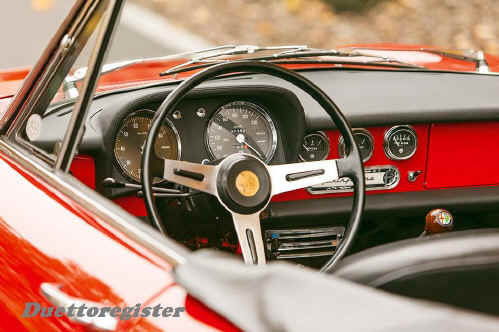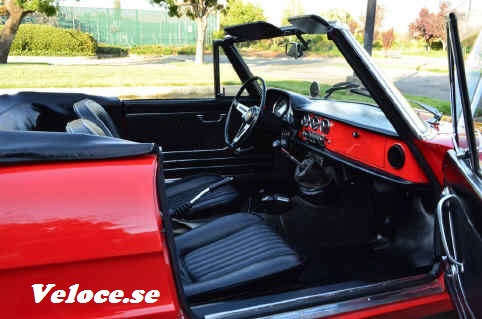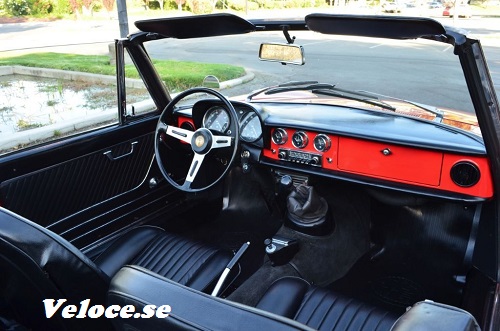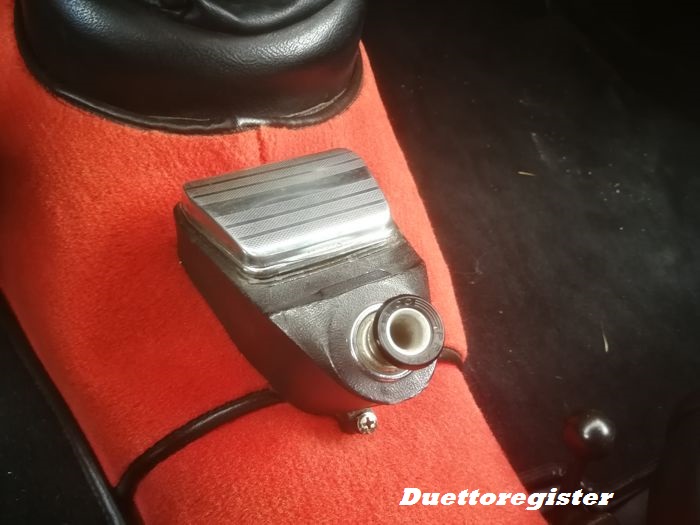
Via Veloce by Wille R. www.veloce.se since November 1995 and still here.
Alfa Romeo Duetto 1966 - 1969 FAQ --![]()
In many ways the Duetto’s interior bucked tradition every bit as much as the exterior. By 1966 the age of vinyl and plastic was well and truly established but criticism was invited over the seemingly basic nature of many of the fittings. What would today be regarded as tasteful simplicity was then chastised in some quarters as Spartanism.

As an example, the main dashboard was simply painted the same colour as the bodywork. Another example was the choice of rubber floor mats instead of carpets, but this had more to do with weatherproofing practicality than penny-pinching. As for the painted dashboard, looking back we can recognise it as a strong design feature.

Unlike the moulded plastic dashboard of the post-1971 Spider Veloce, the dash construction was quite involved. The main dash was a single metal pressing, with a single extra section on the opposite side of the main instrument binnacle. The dashboard top was a moulded plastic item incorporating the main twin-dial binnacle, while underneath the dash were three separate trim pieces and a fuse box support.

The two seats were well-designed and form-fitting, and offered an infinitely rake-adjustable reclining facility, operated by knurled knobs on their inner sides. An outer lever unlocked the seat position for tipping. Fore-and-aft adjustment (up to 16.5cm, or 6˝ inches) was by a small lever positioned under the seat edge closest to the transmission tunnel.
These were upholstered in what Alfa Romeo called "elastic leatherette" (or in American literature "skai") – which is flexible plastic to you and me. The shape of the seat was, it was said, developed by reference to scientific studies of human anatomy. Certainly they were more effective than the quite different seats in other models of the 105 series range. There were nine straight ribs to each seat base and back. Initially the vinyl was plain but at some time during 1967 this was changed to a grained, imitation leather effect. Black was the most common seat colour, but purple, red and beige were also listed.
The ash tray on the early series.

The same seat material – in the same range of colors – was duplicated on the door trims. The inner panel of each door contained a conventional window winder, a door release lever and, on the driver’s door, a hinged door pull. The passenger’s door had a fixed hand grip instead.
Behind the seats of the Duetto was an area that was barely large enough to accommodate two very small children, but it could certainly fit a useful amount of luggage. It was upholstered in a padded vinyl mat that was held in place with popper studs, and was supplemented by extra side lining panels just behind the doors and a rubber mat covering the rear cross-member on the floor. There were also rubber mats covering the door steps.
The standard level of equipment was high, even for a sports car of this period. It included padded sun visors (the passenger’s side incorporating a vanity mirror), a courtesy lamp and a useful ticket pocket in the foot-well.
The cabin was trimmed in a very practical fashion, reflecting its intended role as a top-down car. The floor was covered in weatherproof black rubber matting that incorporated an embossed Alfa Romeo badge in each foot-well. There was also a padded vinyl panel on the driver’s side of the transmission tunnel where the leg might rest against it and panels for the outer footwell sides. The transmission tunnel itself was carpeted (the only area of the Duetto to be so treated), usually in dark grey although red and purple were also listed??. There was one carpet for the gearbox cover and a second piece for the propshaft.
As part of Alfa Romeo’s drive for improved safety standards, the dashboard was padded and covered with black vinyl on its top and bottom edges. The rest of the facia was left in bare body-colour paint, a very effective finish (although it was criticised by some at the time for its ‘cheap’ appearance, the effect has been notably reproduced recently in the Fiat Coupe). The black dash top was described as "reflection-free," while the sun visors were also padded. And the Duetto’s provision of anchorage points for three-point safety belts was by no means universal among car manufacturers, even in 1966.
If you have any comments, please send an E-mail
#